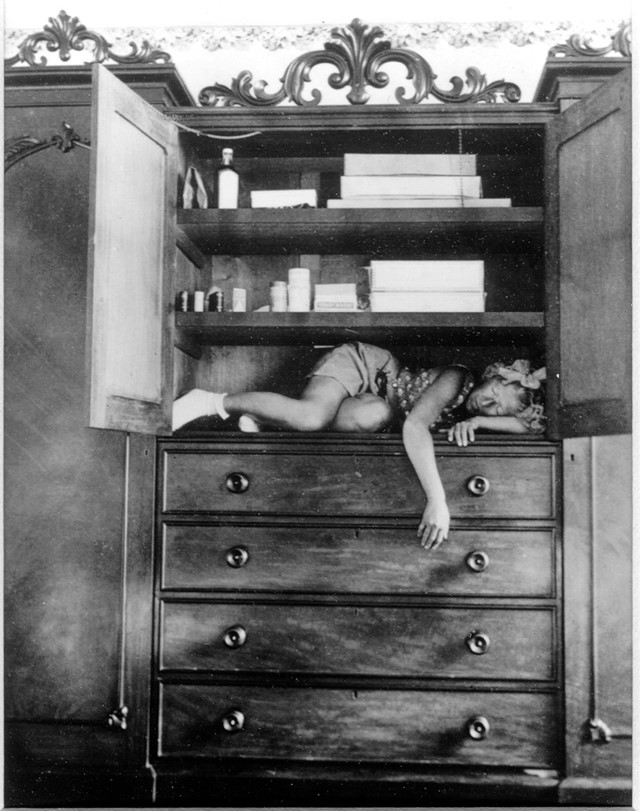



Lucy Renee Mathilde Schwob, later known as Claude Cahun, was a French born surrealist photographer. Claude Cahun was an artistic name specifically chosen for its genderless associations. Reading the name would not instantly be identified as feminine or masculine. She is best known for her self-portraits. She moved to jersey in 1939 to avoid German captivity as a Jew since at the time it was not yet occupied and she’d assumed it would be safe since she’d come to the island previously on holidays when she was younger. She was sentenced to death in 1944 (after she moved to jersey) during the occupation where the Nazis destroyed much of her work. Fortunately the island was liberated the following year. She survived until her natural death in 1954 suspected to be influenced from her time in German captivity.
In life she did not conform to gender stereotypes, shaving her head and wearing male attire and as early as her teenage age years challenged conventional ideals of beauty. She also never exhibited her photographs and saw herself as a writer which rises question as to the purpose of her photographs.
Claude Cahun stripped back her appearance to a genderless face. She shaved her head removing a stereotypical feminine trait. She wore men’s clothes changing a feminine silhouette to an unidentifiable one. She changed her name to a unisex one to leave behind biases. All of these things are associated with a woman and by removing them she was questioning what truly makes a woman and if without dresses, makeup and long hair would people still see her as one.

This image is of two self-portraits layered together. She has a shaved head, no eyebrows and no makeup for an androgynous appearance. This is a common visual across her work linking to bigger themes she liked to tackle such as gender identity. Without long hair she’s not necessarily quickly seen as a woman which builds the question: What makes a woman?
She is positioned in front of a black background so that all focus is focused onto the faces. Her face is lit with bright lights to fully illuminate the whole thing. The shadows cast by her nose shows the light is coming from that direction which is consistent with the second face to create a full image as opposed to two separate portraits stitched together. I would say that he skin looks extremely pale because the images are slightly overexposed which makes her look ill or ghastly which paired with the two faces creates a surreal or supernatural appearing image.
She utilises tone to achieve a unique appearance to her images. The eye is drawn to the brightest things which in this case is her and is a stark difference to the background. There is no mid-tones present in the image which almost makes her look supernatural or like an apparition.
In my opinion, Cahun’s photographs were a way to explore her identity and what made her the way she is while still exploring and experimenting through the art from. She could portray herself however she wanted with the use of personas and ‘masks’. “Behind this mask another mask, there can be no end to these disguises,” is a quote from the writer herself which I believe supports this idea.
This photograph in particular caught my attention because it stitches two different images together. It is in black and white as it was created before digital and has lower resolution then modern images. She would have had to combine the two during production when she was developing. Claude Cahun is centred with two faces. One with darkened eyes whispering into the others ear. This use of lighting successfully creates a sinister appearance which helps to create a story of intrusive thoughts or the devil on her shoulder whispering into her ear. The turned face is used to act like a physical manifestation of her dark thoughts either internally or a representation of exterior influence although by using her own face it seems more like an internal struggle. The act of whispering has connotations of temptation and an act of evil. The use of a dark, smoky background again helps to the darken the image and create a sinister undertone.
I believe the message of this image is that Claude Cahun is her own demon of sorts. She is the one whispering into her own ear and tempting herself, she isn’t blaming anyone/thing else. In terms of identity this shows the two sides of a coin; the front side and the darker side. She cold be maybe repressing a major side of herself or it could be showing how she is two-faced.
The only differences between the faces is the angle, expression, and amount of light reaching her eyes. This could show a number of things:
- That she struggles to differentiate the two faces/ halves of herself as they are so similar.
- The two sides are more similar that she would necessarily like to admit or it would seem at a first glance.
- The two faces are equal parts of what makes her up.
- Only half the second face symbolises she doesn’t fully understand it/she doesn’t see it it for what it is and blames herself. Its purpose is foreign/misunderstood.
